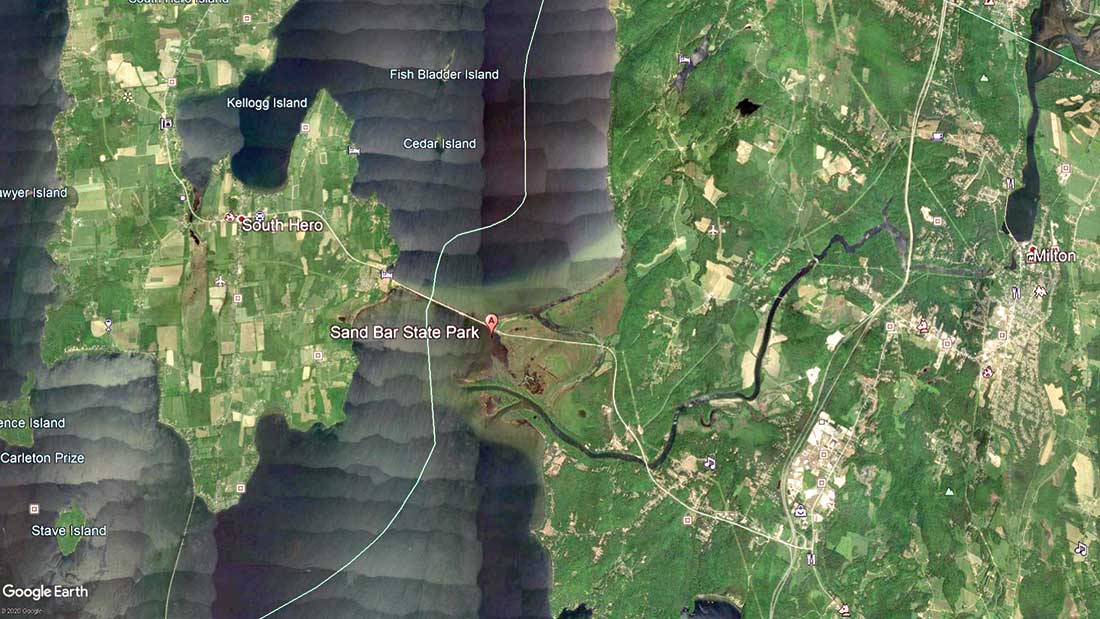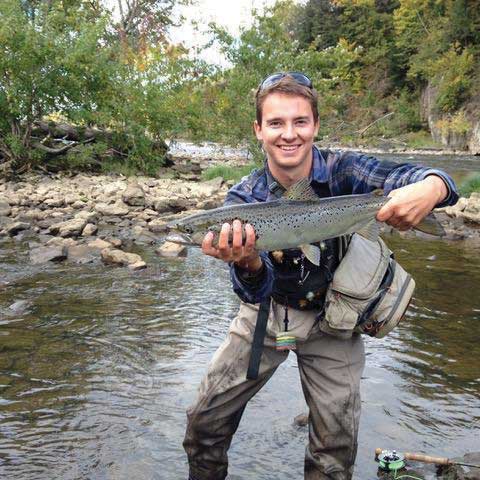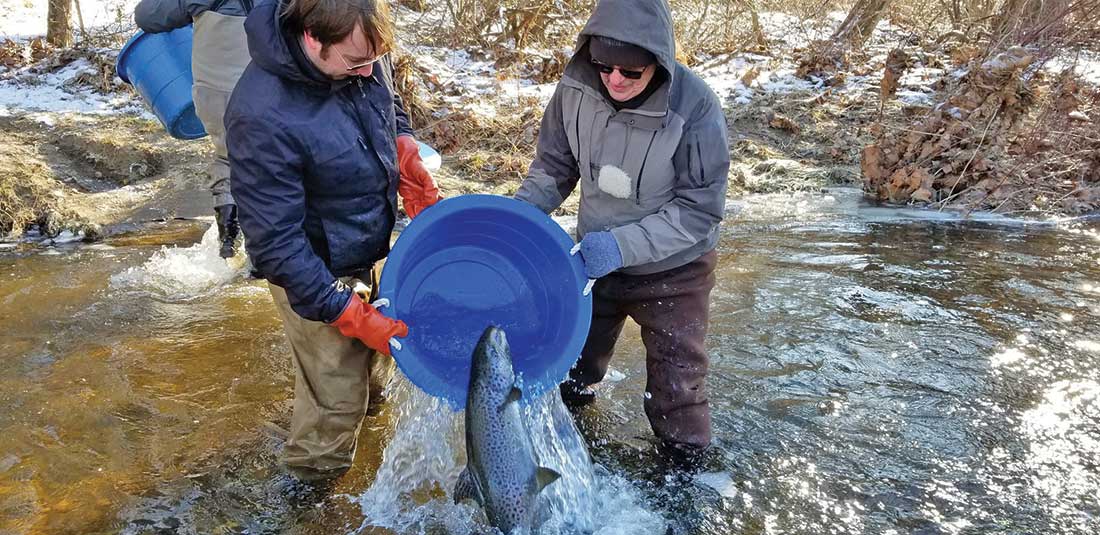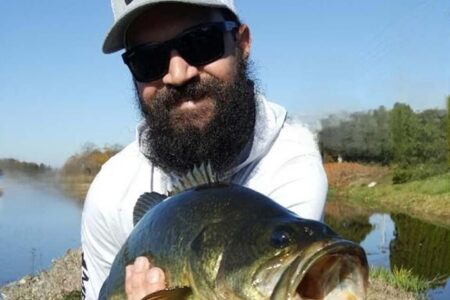
Not as widely distributed as they once were, Atlantic salmon can be found in both lakes and streams of New England.
One spring morning, I launched my kayak near the Sandbar State Park in Milton, Vermont and paddled west to the fill, the opening under the road that allows boats to travel from the bottom end of Lake Champlain to the top. The wind was coming out of the south and my small craft was quickly pushed through. I angled the kayak to take advantage of the leeward side of the causeway, keeping it out of the breeze, and took my fishing rod out of the rodholder behind me. I marveled at how neatly I’d accomplished all of this without any misfortune. I then promptly overthrew my first cast, missing the water completely, and hung the popper I had tied onto my line up on the rocky shore. My messy approach had killed any hope for stealth, as I was forced to paddle into the exact location I’d been eyeing as likely fish habitat to go retrieve it. Once untangled, I pushed away and looked around for another spot where I might place a somewhat less errant cast.
I paddled a bit and found an area where there was a steep drop off and made a cast to it, being careful not to overshoot the shoreline again. The lure hit the surface noisily, well short of my target. I cursed my timidity, retrieved, and made another cast. This time, it landed about a foot from the bank and I started to reel it back in. A fish struck and took off to my right. After only a few seconds, it changed directions, pulling line out as it went. I was happy now, confident that I had hooked a northern pike, a species known for its zig-zag fighting style.
Of course, I was completely wrong and the proof of how errant my identification was emerged moments later as the fish raced to the surface. This is how I lose a lot of good fish, right as they hit the apex of their leap and then unceremoniously spit the hook right back at me. But this one never completely took to the air and instead thrashed at the surface, twisting its body and shaking its head. It surged a second time, but only managed a partial breach. Even so, I was able to get a clear look and there was no doubt as to the species. It was a landlocked salmon.
The landlocked salmon (Salmo salar), like the brook trout (Salvelinus fontinalis), is native to the northeastern United States, differing from rainbow and brown trout, which were both imported to this region in the latter part of the 19th century. Landlocks are essentially the same species as the Atlantic salmon that first inhabited the ocean 10 to 20 million years ago and continue to spawn each year in coastal freshwater streams. Some of them became isolated from the sea at the end of the last ice age, hence their rather apt contemporary name.

While the brook trout is noted for its beautiful markings, particularly the males during the autumn spawn, I think the landlock’s appearance can be at least as striking, if not downright startling. Their backs can easily blend in against the rocks and gravel along the bottom, invisible and ghostlike, until they suddenly launch themselves out of the water. Some folks say they look a bit like brown trout, but you can always tell the difference by looking at the head and tail. The jawline of a landlock extends just under the eye, and its slightly-forked tail is more tapered than a trout’s.
Each spring, landlocks chase spawning rainbow smelt into the tributaries on the New York and Vermont sides of Lake Champlain. The salmon gorge on the smaller fish, which are oily and rich in protein. When the carnage is over, they follow the surviving smelt back into the lake, where they remain throughout the rest of the spring and summer, to wait out the warmer weather and lower stream levels. Once autumn rains boost the river flows again and the water temperature drops, the salmon return to those same tributaries to spawn. They are amazing to watch. They burst out of the deeper pools, skidding through the shallows, their backs sometimes completely out of the water, as they work their way to the safety of the next upstream pool. While swimming through the deeper water, they will excitedly rise and submerge again and again in the rushing current, porpoising.
What’s remarkable is how the activities of the landlocks mirrors those of steelhead trout. In the spring, the steelies head out of the lake to spawn in the streams where they originally hatched. The landlocks follow them and scoop up as many of the freshly-laid eggs as they can. Truth be known, they’ll eat just about anything and after all, the eggs are sitting right there for the taking. In the fall, the steelheads return the favor by following the spawning salmon into those same stretches of river and raid their redds. It’s a wonder that either species is able to procreate. They are creatures of opportunity and so am I. When they’re on the move, I will find any excuse to go after them. However, merely having the will to pursue these fish isn’t always enough to guarantee success.
On a particularly windy afternoon, I stepped out into the flow of one of those many Lake Champlain tributaries, armed with a spinning rod and a handful of spoon lures. In spite of the fact that the water was quite a bit higher and moving a lot faster than I am normally comfortable with, I slowly worked myself out from the shore, along a shallow bar. I shuffled along the top of the gravel and submerged rocks until I stood knee deep in the water at the edge of a point and looked out at a pool directly upstream, where I could see salmon porpoising within casting range.
I tossed a half-ounce Johnson Splinter over the spot where I had last seen one salmon rise and watched as the silver, wedge-shaped piece of metal arched through the air, trailing the line behind it. The lure landed a good 10 feet upstream from where the fish had broken the surface and I began a swift retrieve, so as to keep up with the river’s flow. As I worked the lure through the current, a large salmon jumped clear out of the water off to my left, making a loud splash when it landed. These were some damned frisky fish.
After another 30 minutes of casting, I had a strike and set the hook.
The fish raced with the current and off to my left, parallel to the far shoreline, until it came close to a group of partially exposed rocks a few yards up from the shallow downstream edge of the pool I was fighting it in. Unable, or perhaps unwilling to try to sneak through the low water to escape to the next run, the fish turned its body sideways to me and stopped. While the water between us was moving quickly, the surface was quite still in the wake behind the rock where the fish had chosen to rest. I could see it clearly, a stationary, streamlined silhouette against the light-colored gravel. It moved cautiously a few feet further downstream, where it stopped again, seeming to puzzle out which path offered it the best chance of escape. I knew that I couldn’t muscle the fish across the current and I had enough presence of mind to realize that trying to make my way to where it was suspended was not a good idea either. We were at a stalemate.

Of course, only humans acknowledge the concept of a draw.
The fish threw itself into a headlong run, right at me. I reeled frantically, trying to keep up, but the salmon had taken control of the fight and just before it looked as though it might crash into me, it cut sharply downstream and quite suddenly slowed down, almost to a halt. I spun around and could clearly see its back as it drifted by me, only a few feet away. It was a heavy fish, most likely a female. I could easily spot the glint of my lure, protruding from its jaw. I struggled to keep my balance and to keep pressure on the line. The salmon turned once more, positioning itself to begin a new run, back upstream. My right foot slipped and in the brief moment that I decided to concentrate less on the fish and more on not landing on my butt in the chilly water, the fish threw the hook and was gone.
Ten or 15 years ago, I was a more adept angler. Though it may seem unlikely, I was even capable of taking a salmon on a fly back then without causing serious injury to the fish, myself, or any of the other anglers in the general vicinity. Today though, I possess the grace of a short, overweight bear (picture Yogi Bear’s sidekick, Boo-Boo, without his trademark bowtie or his good sense to know when to leave well enough alone). As such, my plunging into fast running waters and spastically waving any type of fishing rod around has become a riskier proposition than it once was. While I realize that I may have to take a few chances if I aspire to catch a great, wild fish – I have also found that it pays to leave my pride at home when I do that.



